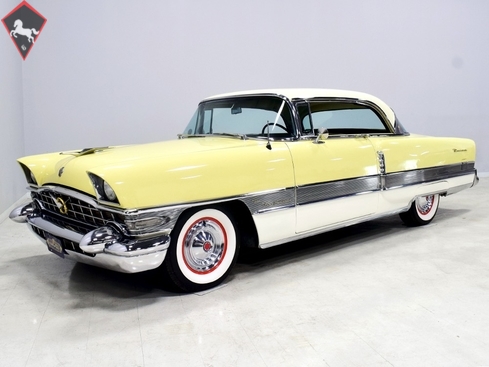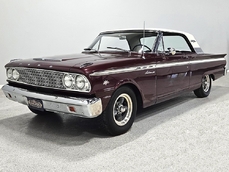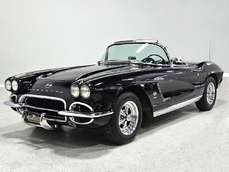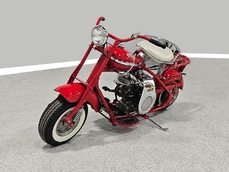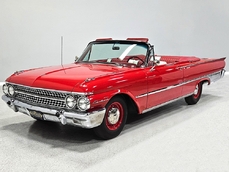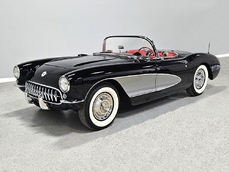Packard 400 374 cubic inch V8 1956
General description :
The 1956 Packards were probably the last cars that can truly be called Packards. After that, they became distinguishable from Studebakers only by trim and badges. So which 1956 Packard should you own if you’re serious about owning something from the ‘50s that isn’t just like everybody else? Our argument would be for the Packard 400, or, as the badging suggests, the Packard “The Four Hundred.” It’s probably safe to think of the The Four Hundred as a hardtop version of the top-of-the-line Caribbean, featuring all the same luxury upgrades and handsome styling with two-tone paint. Oh, and there was that ferociously muscular 374 cubic inch V8, the bulletproof Packard Ultramatic transmission, and the always cool automatic leveling torsion bar suspension. Better still, Packard only built 3224 of them before it was all over, making the The Four Hundred a special car from one of America’s favorite automakers.
This particular The Four Hundred is a largely original car that shows just 67,480 miles from new. It has one repaint some years ago in the original code MP Jamaican Yellow over Dover White, which still looks fantastic today and could almost pass for a very well preserved factory paint job. And while the Caribbean came in wild color combinations, this relatively subtle combination looks like a grown-up’s car and perfectly embodies the ‘50s pastel aesthetic. Packard gave the The Four Hundred that lovely strip of ribbed trim bisecting the sides of the car and providing a dividing line for the two-tone paint jobs, and it’s remarkably well-preserved. Since it’s a casting, it should be subject to pitting, but the trim on this one shows almost zero issues—that’s really extraordinary for one of these cars. In fact, all the chrome and stainless trim is in great shape, from the familiar Packard crest on the nose and tail to the gold anodized “The Four Hundred” emblems to the awesome rear bumper with built-in exhaust tips. Whatever Packard’s financial status may have been in 1956, it didn’t show in their styling.
The two-tone Primrose and Black interior remains almost entirely original as well, and there’s nothing you could do today to replicate that funky brocade fabric. It’s beautifully detailed and very ornate everywhere you look—this car had to be insanely expensive to build. The upholstery is in fantastic condition with the only notable wear being a bit of fraying on the driver’s seat back where someone might grab it to pull the seat into position when in the back seat. The seats are comfortable, there are no split seams, and the door panels are highlighted by more finned trim in equally good shape. There’s a big two-tone steering wheel that was big just because it could be, since power steering was standard equipment. The lovely instrument panel uses a gold-toned mesh as a background, and the theme continues in the gauges that are as ornate as anything from the 1930s. There are a bunch of knobs for everything from the power antenna to the rear speaker, plus separate controls for the heater and defroster. This car has the optional pushbutton control for the Ultramatic transmission, and it works properly—press D and it drops into gear instantly. Press R and you go backwards. Press P when your journey is done. The The Four Hundred makes it easy. It’s noteworthy that everything in the car works except the clock—gauges, fans, the AM radio and both its speakers, and the power antenna. There are switches under the dash for the electric fuel pump, which is useful for priming after a period of inactivity, and one to disable the auto-leveling suspension—believe us, it’s a little disquieting to go out into the garage and hear the The Four Hundred adjusting itself in the dark. The headliner has three or four holes that have been reasonably well patched, but given that it’s original, we think that’s a forgivable sin. There’s also a well-finished trunk wearing its original lining materials and carrying a full-sized spare and jack assembly.
Packard enlarged their first V8 to 374 cubic inches in 1956, which had the side-effect of adding 30 horsepower. Nice! As a result, this Packard feels very energetic on the road, and despite its rather extraordinary heft it steps off with enthusiasm from a stop and cruises effortlessly at speeding-ticket velocities. It’s easily identified by its gold-painted valve covers, but is otherwise unremarkably detailed—black engine block, familiar dual inlet air cleaner, and a Carter 4-barrel carburetor. They did make neat little brackets for the spark plug wires, designed so that the Packard script on the valve covers is not obscured, and service access is pretty good throughout. It starts quickly and easily, idles smoothly, and as I mentioned, pulls this big hardtop around like it weighs 800 pounds less than it does. It has no bad habits, stays cool in traffic, doesn’t smoke, and generally goes about its business like a Packard luxury car should. There’s even a new insulated hood pad to help keep noise and heat at bay.
As I mentioned, the Packard Ultramatic is one of the better-engineered automatic transmissions of the era and it shifts properly. It’s a 3-speed unit, but with 3.54 gears out back and a mountain of torque, the The Four Hundred never feels flat-footed. Look around underneath and you’ll see that spending most of its life in Texas has kept the car’s vitals in excellent condition—just check out that spare tire well! There’s no rot in the floors, the frame shows no signs of ever being bent, and a recent dual exhaust system uses NOS mufflers for exactly the right sound. As I mentioned, the auto-leveling torsion bar suspension works correctly and it’s really an ingenious design that neatly eliminates all the problems the other guys were having with their air springs. There’s recent service work to the brakes, newer shocks, and a few other signs that this car has been properly maintained all its life. Factory steel wheels are finished in bright red for a bit of contrast and wear factory wheel covers and a fresh set of 225/75/15 Diamondback wide whitewall radials.
This particular The Four Hundred includes a lot of factory literature, too, including an owner’s manual, original shop manual, 1956 Packard full line brochure, a salesman’s guide to the torsion bar suspension, paint chips, and a stand-up show board with period advertising. It also comes with a few extra parts and some touch-up paint.
We like the The Four Hundred. It stands out in a crowd of fins and chrome without being excessively showy about it. The two-tone paint scheme is ’50s perfect and the forward-looking styling has aged better than a lot of its contemporaries. Add in the hugely powerful engine, awesome pushbutton transmission, innovative suspension, and you get an icon of the ‘50s with enough gee-whiz tech to engage any child of the Jet Age. It’s also just lovely to drive. And unlike 1956, the Packard is extremely affordable, ringing in at a price that’s probably less than a comparable Chevy—how’s that for value? Call today!
Harwood Motors always recommends and welcomes personal or professional inspections of any vehicle in our inventory prior to purchase.
http://www.harwoodmotors.com/vehicles/inventory_details.php?id=1245
1956 Packard 400 374 cubic inch V8 is listed sold on ClassicDigest in Macedonia by for $32900.
Car Facts
Car type : Car Make : Packard Model : 400 Model Version : 374 cubic inch V8 Engine size : 0.0 Model Year : 1956 Sub type : Coupé Location : Ohio
Sold
Seller Information
Sold
Other cars listed for sale by this dealer
About Packard
Packard: A Comprehensive HistoryEarly Years and Foundation:
Founding: The Packard Motor Car Company was established in 1899 in Warren, Ohio, by James Ward Packard, William Doud Packard, and George Lewis Weiss.
Pioneering Luxury: Initially producing high-quality automobiles, Packard became synonymous with luxury, craftsmanship, and engineering excellence.
Notable Achievements and Contributions:
Packard Twin Six: Introduced in 1916, this V12-powered car established Packard as a premier luxury automobile brand.
Model Line Expansion: Packard expanded its lineup with various models, including sedans, coupes, convertibles, and limousines, catering to affluent customers seeking elegance and performance.
Engineering Innovations: The brand introduced several innovations, such as the first use of aluminum pistons, air conditioning, and the Ultramatic automatic transmission.
Ten Historically Significant Models with Technical Specifications:
Packard Twin Six (1916):
Engine: 7.3L V12 engine.
Performance: Around 85 horsepower.
Packard Eight (1930-1938):
Engine: Straight-8 engine with various displacements.
Performance: Ranged from 90 to over 130 horsepower.
Packard Super Eight (1939-1951):
Engine: Straight-8 engine.
Performance: Produced between 130 to 180 horsepower.
Packard One-Twenty (1935-1942):
Engine: Straight-8 engine.
Performance: Approximately 100 to 120 horsepower.
Packard Clipper (1941-1957):
Engine: V8 engine.
Performance: Ranging from 135 to 185 horsepower.
Packard Caribbean (1953-1956):
Engine: V8 engine.
Performance: Varying between 275 to 310 horsepower.
Packard Patrician (1951-1956):
Engine: Inline-8 and V8 engines.
Performance: Ranged from 150 to 180 horsepower.
Packard Hawk (1958):
Engine: V8 engine.
Performance: Produced around 275 horsepower.
Packard Executive (1956-1958):
Engine: V8 engine.
Performance: Varying between 240 to 290 horsepower.
Packard Predictor (1956):
Engine: Concept car showcasing design and technology.
Performance: Prototype model.
Legacy and Influence:
Quality and Elegance: Packard was revered for its exceptional build quality, refined styling, and luxury features, often considered on par with European luxury brands like Mercedes-Benz.
End of Production: The brand faced financial struggles in the 1950s, leading to its merger with Studebaker and eventual discontinuation in the late 1950s, marking the end of an era in American luxury automobiles.
Packard left an enduring legacy in the automotive industry, symbolizing elegance, engineering excellence, and a commitment to luxury that has been admired and respected by car enthusiasts worldwide.
